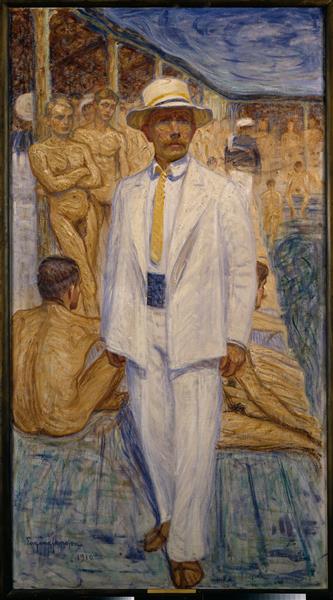Description
The "self -portrait" painting of Eugène Jansson, made in 1910, is a work that encapsulates the introspective essence of the artist and his unique style, characterized by the fluidity in the use of color and exploration of the human figure. Jansson, an outstanding exponent of Swedish art, stood out not only for his talent in the portrait, but also because of his unique vision that integrated elements of symbolism and modernism. This work reflects a deep connection with the artistic movement of the time, which found a way of expression in personal representation.
The composition of "self -portrait" is remarkable for its direct approach to the subject: Jansson himself. It is presented in a contemplative pose, with a look that seems to cross the surface of the fabric, inviting the viewer to a reflection on the being itself. The color palette used is predominant in blue and green tones, which not only reflect a certain melancholy, but are also characteristics of the symbolism that permeates its work. This chromatic choice gives an introspective and almost dreamlike atmosphere to the portrait, accentuating the duality between the external and internal, and between reality and emotion.
The light and loose use of the brush, as well as the textures that it manages to create on the surface, are aspects that demonstrate the master's degree in the management of oil painting, which contributes to a vibrant and multidimensional visual effect. The seemingly fast brushstrokes, in some almost abstract moments, manage to give life to figurative representation, reflecting the influence of pictorial currents such as postimpressionism. It is evident that each line is loaded with emotion, suggesting that the work is both a physical and emotional portrait of the author.
In this work, Jansson does not present additional elements or characters that distract from the main focus, their own figure. This reinforces the importance of self -portrait in artistic tradition as a vehicle for self -exploration and identity. In a broader context, Jansson was part of an artistic movement that sought authenticity and individuality in representation, connecting with other currents of the time that also explored the self and personal perception.
Although "self -portrait" can present a reading in terms of Jansson's life and career, it also invites a broader analysis of the artistic context of the early twentieth century, where artists began to distance themselves from academic norms to explore new forms of expression and subjectivity. Jansson, who often represented the beauty of his natural environment in his landscapes, seems here to use his own image as a reflection of his internal struggles and his personal search for meaning through art.
In conclusion, the "self -portrait" of Eugène Jansson is a clear example of how painting can be a medium not only for representation, but also for emotional and psychic exploration. It is a work that resonates with human experience, inviting the viewer to contemplate not only the artist, but also his own existence and complexity of his internal world. Through this work, Jansson not only introduces himself; It offers a window to introspection and an invitation to reflect on our own identities.
KUADROS ©, a famous paint on your wall.
Hand-made oil painting reproductions, with the quality of professional artists and the distinctive seal of KUADROS ©.
Art reproduction service with satisfaction guarantee. If you are not completely satisfied with the replica of your painting, we refund your money 100%.

